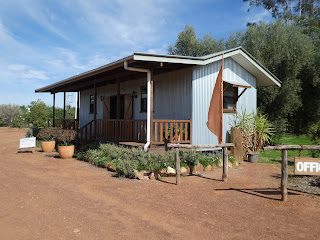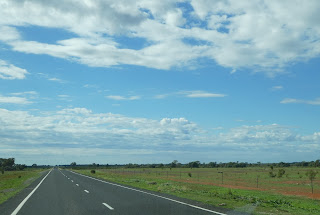What an effort Judy has made with this park. How she has achieved all she has one her own is beyond us. As she told us, she had had some help from time to time with major works, but the gardens and surrounds have all been her own doing.
And the results speak for themselves. Even the dry park roadways (they really would be much better with a good layer of gravel over them, but I know that is not a cheap exercise) do little to detract from the overall 'botanic garden' feel of this delightful oasis.
A great deal of thought has gone into everything. The park office is well positioned to greet those newly arriving, with plenty of nearby parking space.
The polished wooden floors, galvanised iron reception desk with its wood slab top, and all the wall fittings have been designed to present an 'outback' feel, but a very smart one for all that.
The 'galv' theme is carried around the walls and here, opposite the desk, apart from the tourist information stand, another small room houses the park library. This is one classy park reception office indeed.
The park residence nestles amongst large trees behind the office, not too far from the banks of the Warrego River, looking out over one of the many park rose gardens.......yep, that's right, roses in the outback!
Within minutes of arrival here, the extent of the rose plantings becomes obvious.
Large beds of them welcome all visitors making their way down the site access roads. Their delightful blooms (I am a self-confessed 'rose tragic'...our rose garden is one of the few things I miss in no longer owning a house) stood in real contrast to their brown earth surrounds.
And believe it or not, Judy encourages all who spend time here to make sure that they pick one of two to add some colour and fragrance to their vans. We were more than quick to take up this offer!
As I mentioned in my previous missive, the majority of the sites here are angled drive-thrus. Gravel has been laid on most to ensure that mud is not a problem during the wet periods and all come with their own 'private lawn'.
Large shrubs mark the entrances to all sites and form hedgerows between each, providing both privacy and a real garden feel.
It was interesting to compare the developed sites, which were established some seven years ago, to those which have been more recently laid out and planted. In a few years these too will be all be an individual green oasis of privacy.
For those wishing to commune more closely with the nearby river, several sites which allow for the van to be backed up to the edge of the bank, cater for that need.
One thing which did perturb us a little on arrival was the sight which greeted us near the entrance, where a long, shallow puddle was a reminder of the recent rains.
 Even from the cabin of the Cruiser we could see that its muddy surface was teeming with mosquitoes. I am pleased to report that we were not bothered by them in the park itself, although a liberal spray of repellent was the first thing we did each morning when emerging to greet the day.
Even from the cabin of the Cruiser we could see that its muddy surface was teeming with mosquitoes. I am pleased to report that we were not bothered by them in the park itself, although a liberal spray of repellent was the first thing we did each morning when emerging to greet the day.
But back to the park itself. The pathway to the large and very well established and equipped amenities block was lined with trees and shrubs,
the majority of which were more than just decorative. The red orbs of pomegranates contrasted with the smaller yellow fruits of the tree opposite whilst not too far away other trees were laden with lemons and limes......all of which were there for the taking by park guests.
In addition to the fruit trees and decorative shrubs, these gardens are splashed with colour,
presented in places in some very interesting ways.
The large amenities building has been designed with a central park laundry

and here I discovered that as well as being highly enterprising, Judy had a sense of humour to match. This was just one of several entertaining notices posted on the laundry wall.

The ablution areas run off to each side of the laundry area

and here again the theme of outback tin and wood was continued in a very well designed, functional and spotlessly clean facility which included huge shower areas with a more than adequate hot water supply (something which can be tricky in some of these outback towns).

Adjacent to the head, where this patch of lawn was undergoing some rejuvenation,

the large camp kitchen has also been designed to continue the outback theme.

Its cavernous interior has been st up for large group gatherings

with BBQ cooking facilities to match

even if the old wood stove appeared to have well and truly passed its 'use by' date! But here again, the retention of this piece of equipment was right on message in respect of how this park is set up.

Another large expanse of thick lawn and yet more trees can be found behind the amenities block,

and here were more patches of welcome colour.

Some fifty metres or so from the camp kitchen area the outdoor 'happy hour' fire pit has been established right on the banks of the river.

There was certainly no shortage of fuel!

As I wandered across to snap away in this area, a rustle in the branches overhead and a familiar cry alerted me to the fact that one of our favourite birds of the east coast of Australia was nearby. This determinedly acrobatic Blue-Faced Honeyeater was hard at it. No insect in this tree was safe!
The ash pit on the river bank bore testimony to the fact that the afternoon fires we were about to enjoy would not be the first lit here by any means.

And our luck was in! On the second afternoon of our stay here, as a small but cheerful group gathered fireside, one of our fellow travellers wandered down and asked if anyone would mind if he sang a song or two. "Go ahead good sir", was the unanimous reply.

We had no idea how good this chap was, but as the dropping sun began to tinge the few clouds and colour the brown waters of the Warrego with a splash of pink,

our newly arrived troubadour proved to be more than entertaining, both with his skill and his selection of songs. What a wonderful way this was to end our day.
You will see from this last shot that the river flowing past our park was a far cry from a shallow stream. And, leaving aside the contribution of the recent rains, there is a very good reason for this.

Weir Road is well named. A few kilometres past our park entrance, this substantial cement construction does a great job in holding back the waters of the Warrego downstream of Cunnamulla.
I did take the opportunity to scoot on down to the nearby boat landing pontoon in the hope of being able to better see the build up of water upstream of the weir.

Mission accomplished!
The Warrego is an interesting river.
The most northerly of the rivers which flow into the Darling, it rises in the Canarvon Range near the little town of Tambo and then flows 900 kilometres, generally south, through the outback Queensland towns of Augathella, Charleville, Wyandra and Cunnamulla before crossing into New South Wales and finally joining the Darling River downstream of Bourke.
Its catchment covers 7% of the Murray-Darling Basin, but this stream provides only a 1% contribution to the Basin water.
The storage here at Cunnamulla holds just under 5 gigalitres and is critical to the water security of the town and the area which immediately surrounds it (and is pretty useful in providing two kilometres of good river frontage for the park!).
It is what is classed as an 'intermittent' river. Its flows are very seasonal, but even in the driest years, a retained series of water holes provide critical habitat for the fish which inhabit it.
Mind you, when it floods it does not do so by halves. These can normally be expected during 'La Nina' weather events, such as in the years of 1950, 1954 to 56, 1971, 1973, 1998 and 2008, but this is not always the case. Wikipedia notes that:
"Oddly, the most destructive flood ever recorded on the river took place in the absence of La Niña. In April 1990, as a result of two extremely strong troughs in the easterlies, over 400 millimetres (16 in) of rain fell in Cunnamulla in two weeks, being more than the annual rainfall in over 60 percent of years. The river, along with most tributaries of the Darling, reached near-record levels and the towns of Augathella and Charleville were devastated. At Charleville a river height peak of 8.54 metres (28.0 ft) was recorded."
We have experienced the vagaries of the Warrego ourselves, when travelling south three years ago. Although the flooding did not reach anywhere near the levels of the major inundations, you may recall that we just squeaked out of Tambo by the skins of our teeth, galloped through Augathella at the rate of knots, and had to avoid Charleville at all costs as the town was completely isolated by the flooded Warrego River.
As I have noted before, "A land of droughts and flooding rains"!
But I have digressed. As I hope you have now seen, we could not have been happier about our decision to put our travelling feet up here at the Warrego Riverside park, and as I noted in the title of this offering, 'how things have grown' since we first saw it seven years ago.
This establishment is a real credit to the vision and hard graft of its owner, Judy.




























































